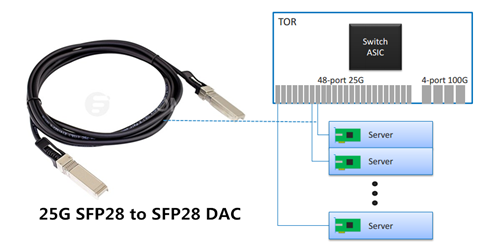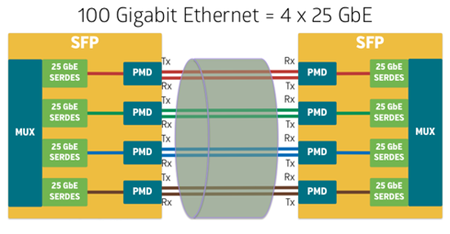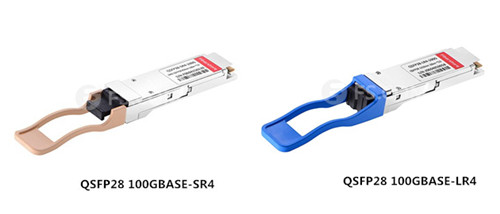The traditional migration path from 10G to 40/100G is widely acknowledged by network installer. People are turning to upgrade to 40G using QSFP+ transceiver. However, migrating from 10G to 40G is a big jump, optical technicians wonder if there is a better solution to replace the existing 10GbE-40GbE-100GbE path. Under this circumstance, a new migration path 10GbE-25GbE-100GbE is given birth. What is 25GbE? Why should subscribers choose to migrate to 25GbE instead of 40GbE? Today’s article will provide some detailed information about this new Ethernet to help you figure out the best migration path to 100GbE.
What Is 25 Gigabit Ethernet?
25 Gigabit Ethernet or 25GbE, is a proposed standard for Ethernet connectivity that will benefit cloud and enterprise data center environments. This specification recommends a single-lane 25 GbE and dual-lane 50 GbE link protocols. 25 GbE leverages technology defined for 100 Gigabit Ethernet implemented as four 25 Gbit/s lanes (IEEE 802.3bj) running on four fibers or copper pairs. Telecommunication companies like Google, Microsoft, Arista, and Mellanox are pushing the development of 25 Gigabit Ethernet standard for top-of-tack server networking. Relevant transceiver modules and optical cables like 25G SFP28 and SFP28 DAC cables are developed to support this technology.

To help you have a better understanding of the 25GbE, a short description about 40GbE will be provided below. The IEEE P802.3ba 40G and 100G Ethernet Task Force was formed to develop a 40 Gigabit Ethernet and 100 Gigabit Ethernet draft standard. At the physical layer, 40G Ethernet is essentially 4×10G lanes. Standards-based 40G Ethernet switches and routers are starting to show up in enterprise networks, following ratification of the IEEE 802.3ba specification in mid-2010. QSFP+ modules and 40G DAC cables are introduced to back 40G networking, which are warmly welcomed by network designers. For example, QSFP-40GE-LR4 is Cisco QSFP+ 40GBASE-LR4 transceiver. It can be used in a 4×10G modules with 10GBASE-LR interfaces.
Why Need 25 Gigabit Ethernet for Your Server?
As noted before, 25GbE networks enable organizations to significantly use one single lane of 25Gbqs, while the design of 40GbE was based on 10GbE. Thus if we use 10GbE—40GbE—100GbE path, we have to use ten 10 GbE lanes in the network. But when we turn to 25GbE, we only need to use four 25GbE lanes to realize 100GbE see in the following figure. In the high-density data center, using multiple 10GbE requires more switches, resulting in more space, power and expense. In addition, less network components also reduce ongoing management and maintenance.

In addition, the proposed 25 GbE standard reduces the number of lanes on the chip makes it less expensive to produce and less power-hungry. It also simplifies the process with just minor changes for forward error correction and lane alignment when compared to 40 GbE. To sum up, getting 25 GbE performance for the same price of 10G combined with reduced operating costs, which makes itself a compelling proposal for migration.
On the other hand, the 40GbE specification defines a wide range of port types and has been ratified by IEEE. 40G optical equipment are all compatible with the existing 10G devices. Take JG330A as an example, it is HP QSFP+ to 4SFP+ passive copper cable offering a cost-effective solution to establish a 40G link between QSFP port and SFP+ within racks and across adjacent racks. However, 25GbE transceiver modules like QSFP28 and SFP28 will not be compatible with the existing QSFP+ and SFP+ cable assemblies, which cause trouble to users.
Right Move at the Right Time
25GbE might be an unknown network item for designers, but a big progress for telecommunication field. After going through the whole, people may still hold different opinions towards the future of 25G and 40G. Some believe that the dominant next-generation server connection speed is going to be 25G, but some confirm that 40G between switches is expected to remain and will not be affected by this development. We can not sure which one is right. Just remember to make the right move at the right time.
25G Optical Solutions
The SFP28 and QSFP28 transceivers and interconnect cables are high-density, high-speed product solution designed for 25GbE and 100GbE applications. The emergence of these two form-factors pluggable certainly reflect the trend in the industry to aggressively bring 100GE density up and costs down. SFP28 optical transceiver enables a new generation of high-density 25G Ethernet switches and NIC cards, facilitating server connectivity in data centers, and a conventional and cost-effective upgrade path for enterprises deploying 10G Ethernet links today in the ubiquitous SFP+ form factor.

QSFP28 transceiver, as a new type of 100G transceivers, offers four channels of high-speed differential signals with data rates ranging from 25 Gbps up to potentially 40 Gbps, and will meet 100 Gbps Ethernet (4×25 Gbps) and 100 Gbps 4X InfiniBand Enhanced Data Rate (EDR) requirements. According to IEEE 802.3bm, the 100GBASE-SR4 QSFP28 is designed for multimode application and support maximum link length of 100 m over OM4 Fiber. The 100BASE-LR4 QSFP28 is designed for single-mode application which support maximum link length of 10 km over SMF. QSFP28 has the same footprint and faceplate density as QSFP+ and is just slightly smaller than CFP4. Theoretically, QSFP28 seems to have the density advantage over CFP4.
Fiberstore is committed to provide cost competitive long-reach option for mainstream customers. We are very glad to offer our expertise in choosing the physical infrastructure that best meets your needs. We offer a wide variety of 25G optic solutions including 25G SFP28, SFP28 DAC cables. If you have any requirement of our products, you can directly contact us.
评论
发表评论